
We’ve all been there. You’re in the middle of preparing a delicious dish, and suddenly you realize you’re out of rosemary. Panic sets in. You reach for the spice cabinet and ponder what herbs and spices you have that can step in and save the day.
Rosemary’s needle-like leaves are not just a treat for the eyes but also a delight for the palate. Predominantly known for its woody taste, rosemary has been a staple in many kitchens. But what happens when you run out of this aromatic herb? Fear not, for there are several alternatives that can come to your rescue. From thyme to oregano, basil to marjoram, the choices are varied and versatile.
Whether you’re looking for a fresh or dried substitute, the options are plentiful. So, let’s explore the world of rosemary substitutes together, and I promise, your dish will be just as delightful, if not more!
1. Bay Leaf
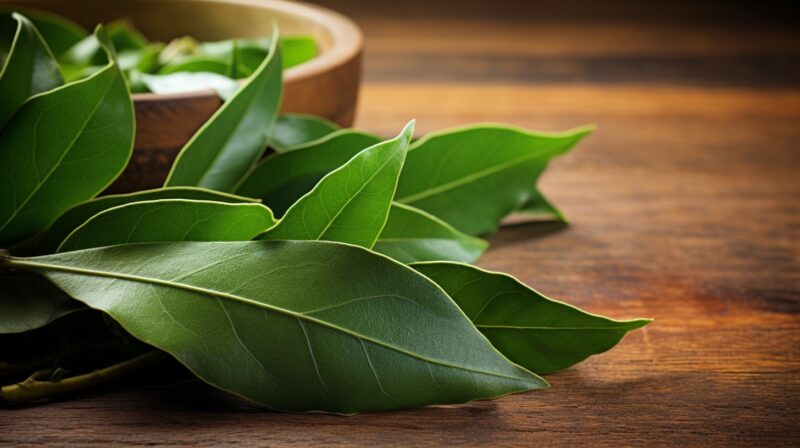
You might not have rosemary on your herb shelf, but bay leaf is surely there!
Experienced cooks use it so often that we usually forget what’s the bay leaf’s role exactly. This sweet herb is known for its pleasant aroma and various culinary benefits.
The first rosemary substitute on my list is native to Asia Minor. However, it is grown into other parts of the Mediterranean and Asia too.
The best way to use bay leaves as rosemary substitute is to combine them with thyme and peppermint. This mixture will drastically improve the aroma of your lamb dishes and make your family drool over it as soon as you take it out of the oven.
Bay leaves are rarely used fresh, because of their gently bitter flavor, which is why you should dry them in the sun for several hours. Fortunately, their pleasant aroma is retained even after sun exposure.
Bay leaves are rich in calcium, copper, iron, magnesium, manganese, and selenium. They offer many medicinal properties, such as respiratory system enhancement or management of diabetes.
Top Benefits of Bay Leaf
- Immune System Health: Bay leaf is a good source of vitamin A, vitamin B6, and vitamin C, all of which are known to support a healthy immune system.
- Digestive Aid: Bay leaf tea can help ease bouts of an upset stomach. The tea is also aromatic, which can help relieve sinus pressure or a stuffy nose.
- Reduces Type 2 Diabetes Risk Factors: Some studies suggest that bay leaf may lower blood sugar levels.
- Rich in Vitamins and Minerals: Bay leaf is a good source of vitamin A, vitamin C, vitamin B6, calcium, iron, and manganese.
- Aromatic: Bay leaf can add a unique flavor to dishes and make aromatic tea.
Top 5 Dishes Bay Leaf
- Soups, like Mexican posole
- Beef stew.
- Garam masala recipes using Indian bay leaf
- Marinades for beef or chicken
- Thai or Laotian curries
2. Caraway Seed
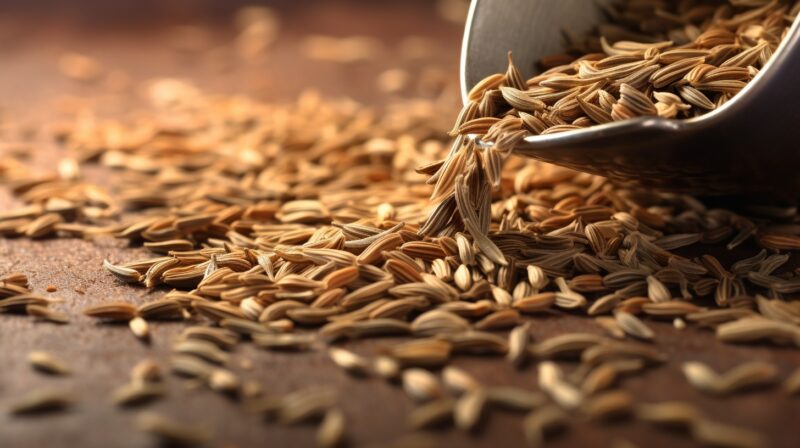
If you are looking for a reliable rosemary substitute, that won’t overpower the other herbs you use to season your dish; caraway seed is an excellent choice. You should remember that this is a strongly flavored spice, and you should use it in recipes that require strong seasonings such as poached fish, pork roast, salads, and sausage dishes.
Caraway seed is native to central Europe, but you can also find it in the Mediterranean and the Middle East. It belongs to the carrot family, and its roots are edible as well.
Don’t forget how aromatic caraway seeds are; their anise flavor is quite distinctive. One teaspoon of this spice will be sufficient for any dish.
Caraway seeds are rich in dietary fiber, vitamin A, C and E, copper, magnesium, potassium, and selenium. They aid digestion, physiological functioning, body development, and red blood cells formation.
Top Benefits of Caraway Seed
- Lower Risk of Inflammation: Caraway seeds have the potential to help reduce chronic inflammation, which is connected to many chronic conditions like heart disease, dementia, and arthritis.
- Improved Digestion: Caraway seeds have been historically used to reduce symptoms of dyspepsia (indigestion). Modern scientific studies support this claim, suggesting that caraway oil can help reduce discomfort in the digestive tract.
- Aid in Weight Maintenance: Some studies suggest that consuming caraway extract could help maintain or reduce weight.
- Rich Source of Antioxidants: Caraway seeds contain significant amounts of lutein and zeaxanthin, which are linked to a reduction in dangerous free radicals.
- Heart Health: The antioxidants in caraway seeds have been linked to a reduced risk of heart disease, atherosclerosis, and high blood pressure.
Top 5 Dishes for Caraway Seed
- Cheese dishes
- Meat dishes
- Sauerkraut
- Breads and pastries
- Soups and stews
3. Marjoram
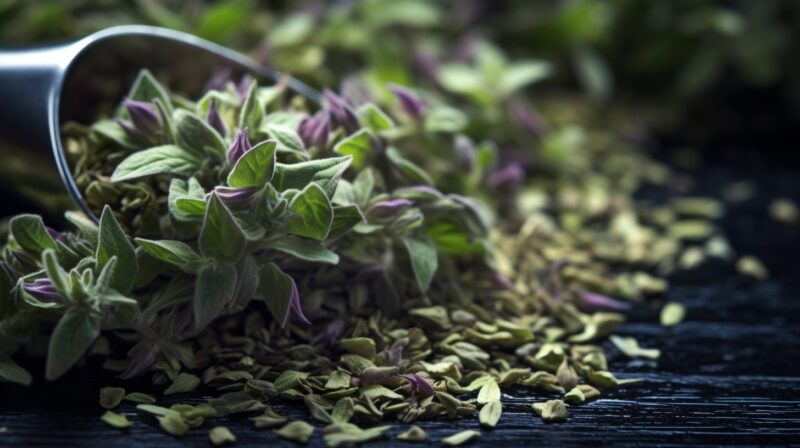
Marjoram (or Origanum Majorana) has sweet, aromatic flavor comparable to thyme. It is native to Cyprus and Eastern Turkey, so it is no surprise that you will most commonly come across marjoram in Mediterranean cuisine. It is a vital ingredient in many French, Italian and Northern European sauces.
Dried marjoram works best with mushrooms and tomatoes. If you decide to use it in place of rosemary, make sure to add a bit more to compensate for its gentleness. The trick is to add marjoram to your dishes once the cooling is almost completed. This way, it will retain its spiciness.
Marjoram is rich in vitamin B6, C, K, and dietary fiber while at the same time being low in sodium, cholesterol and saturated fats. It will provide your body with necessary calcium, folic acids, manganese, and magnesium.
You can count on this herb to help improve your cardiovascular system, fight skin wrinkling, and acne. It is also characterized by powerful, antioxidant, antiviral and antibacterial properties.
Top Benefits of Marjoram
- Antioxidant Properties: Marjoram is an excellent source of antioxidants such as tannins, luteolin, and apigenin.
- Vitamin Rich: It is rich in essential vitamins like vitamin A, vitamin C, and vitamin K.
- Mineral Content: Marjoram contains essential minerals like calcium, copper, manganese, and iron.
- Digestive Aid: Marjoram has traditionally been used to help with digestion.
- Culinary Herb: Marjoram is one of the most popular culinary herbs in the world, adding a unique flavor to various dishes.
Top 5 Dishes Marjoram
- Mediterranean and Greek recipes.
- Seasoning for stews.
- Soups.
- Salads.
- Roasts and sauces.
4. Savory
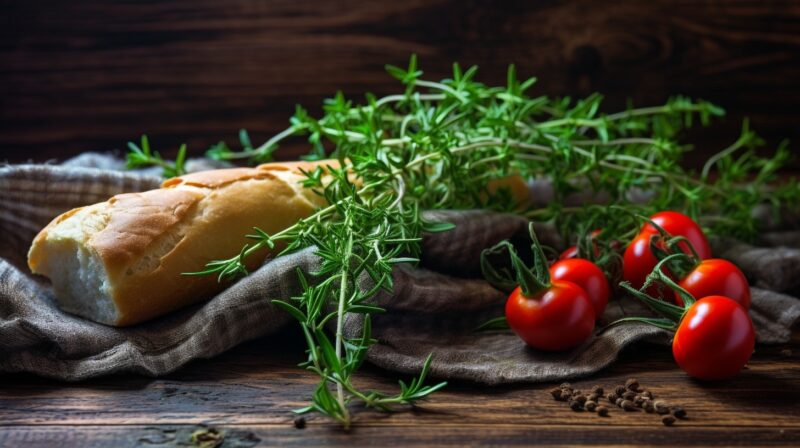
First, a friendly warning: there are two types of savory – winter and summer.
Winter savory doesn’t have much resemblance to rosemary, as its flavor is quite bitter and less delicate. Make sure you are using its summer counterpart, also known as Satureja Hortensis if you want to find an adequate substitute for rosemary.
You will come across summer savory if you try any dish from traditional Canadian, Bulgarian or Romanian cuisine. If you want to use summer savory, it is best to do it when cooking poultry dishes. In this case, these two herbs can also be mixed, and the results will be spectacular.
Summer savory is an indisputable part of various casseroles, meatloaves, slow-cooked meals, lentils, and beans. It can also be used in scrambled eggs along with parsley as a garnish. You can add it to a variety of sauces to enhance their aroma.
Summer savory has antiseptic and disinfectant properties. It is rich with vitamin A, B6, C, calcium, iron and magnesium.
It can be found as an ingredient in soaps and toothpaste. At last, it is commonly used to treat diarrhea, indigestion, flatulence and relieve sore throats.
Most importantly, you can grow it in your garden!
Top Benefits of Summer Savory:
- Digestive Aid: Summer savory is traditionally used to alleviate digestive complaints.
- Cough and Sore Throat Relief: People take summer savory for coughs and sore throats.
- Rich in Antioxidants: The herb contains chemicals that are thought to decrease muscle spasms and kill bacteria and fungus.
- Culinary Spice: In foods, summer savory is used as a culinary spice, adding a unique flavor to various dishes.
- Aromatic Oil: The oil from summer savory is used as a flavoring agent and for its potential health benefits.
Top 5 Dishes Summer Savory
The source mentions that both dried and fresh summer savory are frequently used in many Mediterranean and Greek recipes. However, specific dishes are not listed. Based on common culinary knowledge:
- Bean dishes (as it’s traditionally known as the “bean herb”)
- Meat dishes, especially poultry and lamb
- Soups and stews
- Egg dishes, like omelets
- Vegetable dishes, especially with green beans or lentils
5. Tarragon
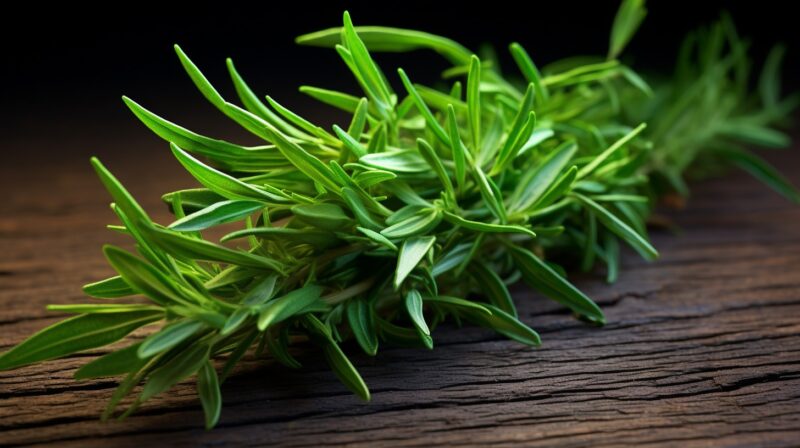
If you have tarragon in your kitchen cabinet, you are in luck, because tarragon and rosemary are interchangeable.
This intensely flavored spice belongs to the sunflower family, and it is native to North America and Eurasia. It is rich in fragrance and has a licorice undertone.
If you enjoy French cuisine, you are no stranger to tarragon which represents an essential spice for the preparation of the famous Béarnaise sauce.
Most commonly, a quarter of a cup proportion is applied when you are using fresh tarragon or one teaspoon if you go with a dried option. Whether you like French recipes or not, this herb goes well with chicken, fish, other poultry, and cheese. If you add a little onion and mustard, you can also have a delicious soup or a stew.
Go big or go home is not a rule you should follow when buying tarragon. This spice is best purchased in small portions. Chop it and store it in your fridge, so it doesn’t lose its unique aroma. Extended storage is not advisable.
Make sure to wash the tarragon before using it and add it to the dish as soon as you can, so it can retain its flavor and taste.
It is rich in vitamins A, B, C, calcium, copper, iron and magnesium. At the same time, its medical properties have been found useful in appetite stimulation and anorexia symptoms alleviation. You can also expect it to reduce your blood-sugar level and offer you some antioxidant benefits.
Top Benefits of Tarragon
- Digestive Aid: Tarragon has traditionally been used to alleviate digestive complaints.
- Blood Sugar Regulation: Tarragon has been found to help improve insulin sensitivity and the way your body uses glucose.
- Sleep Quality Improvement: The Artemisia group of plants, which includes tarragon, may have a sedative effect and improve sleep quality.
- Appetite Stimulation: Tarragon may help increase feelings of hunger by reducing leptin levels in the body.
- Pain Management: Tarragon has been used in traditional folk medicine to treat pain, and studies in mice have found it beneficial for pain treatment.
- Natural Food Preservative: Tarragon essential oil may inhibit bacteria that cause foodborne illness, making it a potential natural preservative.
Top 5 Dishes Tarragon
- Scrambled or fried eggs
- Roasted chicken
- Sauces, such as pesto or aioli
- Fish dishes, especially salmon or tuna
- Roasted vegetables drizzled with olive oil and tarragon
6. Thyme
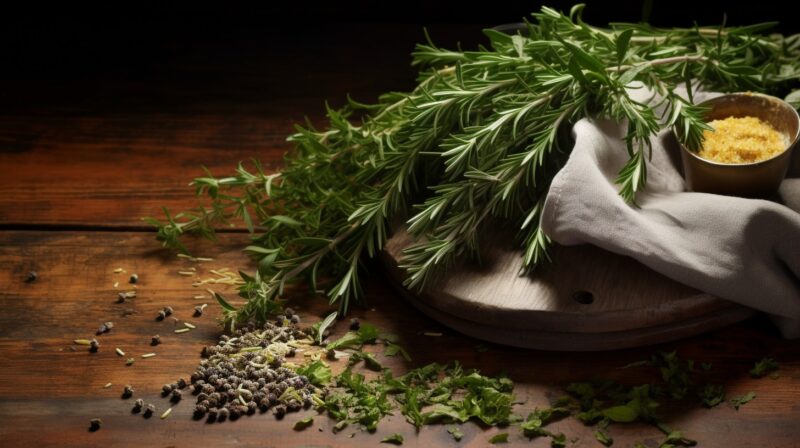
The last but not the least on our list is thyme. This is one of the best rosemary substitutes you can find. These two herbs are similar in appearance, and they both have a warm, peppery undertone.
This is no surprise, as thyme belongs to the mint plant family. Its aroma can also be described as similar to caraway, eucalyptus, and lemon. As you can see, there is a certain sharpness to its scent.
This herb is native to Egypt and Greece, but you can find it all around Europe. Whether you decide to use it dried or fresh, its delicate flavor will agree with various soups, casseroles, and sautéed vegetables. You can also use it to enhance the taste of fish, eggs, and meat.
All you have to do is find the right dosage for your dish. For example, one quarter to half teaspoon of diced thyme will be sufficient for both meat seasoning and eggs scrambling.
The most significant advantage of thyme is that it is widely available and you can get it at your local grocery store or grow it in your garden or indoors
Thyme is rich in vitamin A, B6 and C, calcium, iron and magnesium. It has antiseptic, antimicrobial and anti-inflammatory properties which makes it an excellent immunity booster.
This herb is also a frequent ingredient of cosmetic products such as antibacterial acne remedies, perfumes, and soaps.
Top Benefits of Thyme
- Digestive Aid: Thyme has traditionally been used to alleviate digestive complaints.
- Antibacterial Properties: Thyme is known for its antibacterial properties, especially against P. acnes, the bacteria thought to cause acne.
- Blood Pressure Regulation: A species of thyme found in Pakistan and Afghanistan was found to lower heart rate in rats with high blood pressure.
- Natural Cough Remedy: Thyme essential oil is often used as a natural remedy for coughs and symptoms of acute bronchitis.
- Rich in Vitamins and Minerals: Thyme is packed with nutrients, including vitamin A, vitamin C, copper, fiber, iron, and manganese.
- Natural Disinfectant: Thyme oil may be effective at controlling mold and can be used as a disinfectant in areas with low mold concentration.
- Pest Repellant: Thyme essential oil has been shown to be effective against mosquitoes and their larvae.
- Mood-Boosting Properties: Thyme essential oil, due to its active substance carvacrol, has been shown to increase concentrations of serotonin and dopamine, hormones that regulate mood.
- Potential Anti-Cancer Properties: Some studies have indicated that thyme essential oils might inhibit certain cancer cell lines.
Top 5 Dishes Thyme
- Pesto sauce, as a unique flavoring ingredient
- Meat or poultry dishes, especially when roasted
- Fish recipes, enhancing the natural flavors
- Whole wheat macaroni and cheese with mushrooms
- Thyme-infused oil, which can be used in various dishes
FAQ

How do I know which rosemary substitute to use in my recipe?
Choosing the right rosemary substitute for your recipe depends on the flavor profile you want to achieve. For example, if you’re looking for a herb that has a similar aroma to rosemary, thyme or marjoram may be good choices. If you want a spice that is less potent than rosemary, bay leaves or caraway seeds may work well. Consider the other ingredients in your recipe and the flavor profile you want to create when selecting a substitute for rosemary.
Can I use dried rosemary as a substitute for fresh rosemary?
Yes, you can use dried rosemary as a substitute for fresh rosemary, but you should use less of it. One-quarter of a teaspoon of dried rosemary is equivalent to one teaspoon of fresh rosemary. It’s also important to note that the flavor of dried rosemary may be more concentrated than fresh rosemary, so you may want to adjust the amount you use based on your personal taste preferences.
Are there any substitutes for rosemary that I should avoid using?
While there are many substitutes for rosemary that can work well in recipes, there are some that you may want to avoid. For example, using too much caraway seed can overpower other flavors in your recipe, so it’s important to use it in moderation. Additionally, winter savory has a bitter flavor that may not be suitable for all recipes, so it’s best to use its summer counterpart, also known as Satureja Hortensis, as a substitute for rosemary.
Can I mix different rosemary substitutes together?
Yes, you can mix different rosemary substitutes together to create a unique flavor profile. For example, bay leaves, thyme, and peppermint can be combined to enhance the aroma of lamb dishes. Summer savory and rosemary can be mixed to season poultry dishes. Experiment with different combinations of rosemary substitutes to find the perfect blend for your recipe.
Conclusion
Finding the perfect substitute for rosemary might initially seem like a daunting task, given its unique flavor profile and aromatic presence. However, as we’ve explored, the culinary world is abundant with herbs and spices that can step in, offering both similar and contrasting flavors to elevate our dishes.
Whether you’re reaching for thyme, oregano, or any of the other alternatives we’ve discussed, remember that cooking is as much about experimentation as it is about tradition. So, the next time you find your rosemary jar empty, see it as an opportunity to venture into new aromatic territories and discover flavors you might have otherwise overlooked.
Happy cooking!
Related Posts:
- What Can You Use as Chili Paste Substitute? - Best…
- 10 Dijon Mustard Substitute You Can Pick Anytime -…
- Demerara Sugar Substitute: What to Use Instead of…
- 7 Best Star Wars Waffle Makers 2023 - Best Way to…
- 10 Best Kitchen Exhaust Fans in 2023 - Get the Best Airflow
- 12 Best Oven for Baking Cakes 2023 - Choosing the…




















